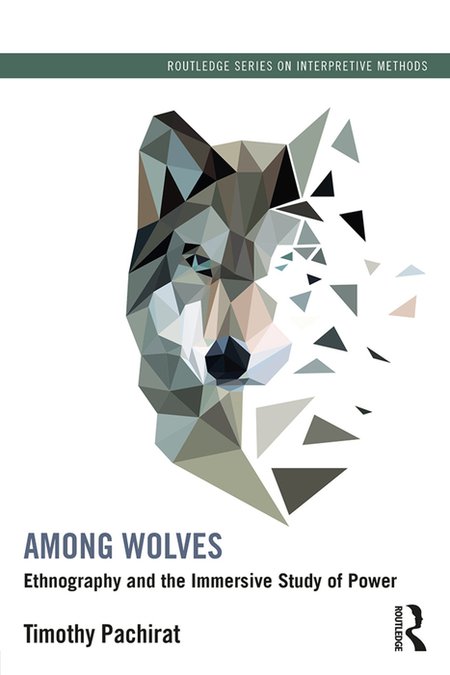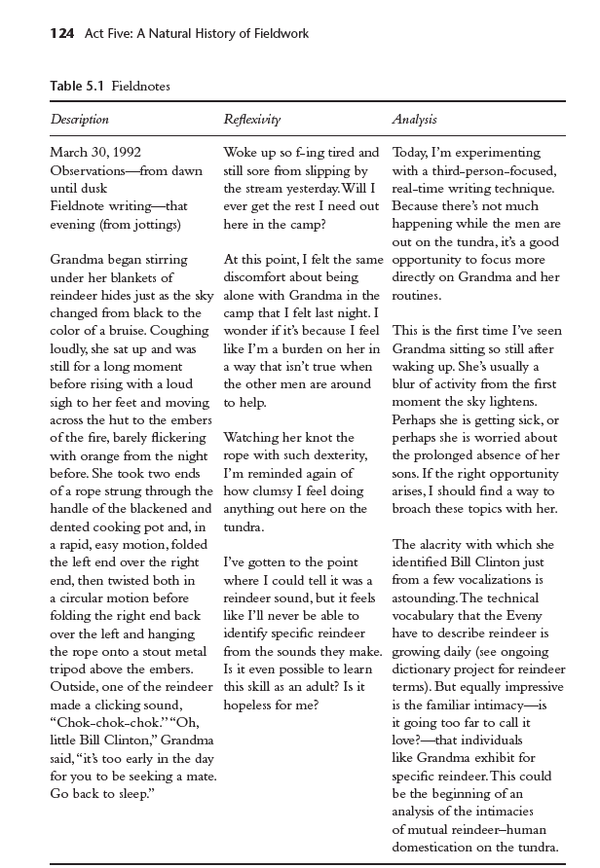
Timothy Pachirat. Among wolves: Ethnography and the immersive study of power. Routledge, 2017.
Fieldwork is often seen as a trial by fire. There are few ways to prepare beforehand for the 'encounters' in the field, and as such, it requires a radical openness from the researcher. Nevertheless, fieldwork is also about discipline, reflection and, often, is followed by an imperative to write up one's findings!
Timothy Pachirat's fictional play, Among Wolves, is a "how-to" guide to fieldwork. It features contemporary anthropologists Karen Ho, Anna Tsing, and Piers Vitebsky, sociologists Mitchell Duneier, Alice Goffman, and Loïc Wacquant, political scientists Séverine Autesserre and James C. Scott, and journalist Katherine Boo. Together they explore ethnography as a method, as the book works up to a "trial" of Alice Goffman's much-discussed 2014 ethnography, "On the Run: Fugitive Life in an American City".
In this article are selections from the book on the importance of writing fieldnotes:
Fieldnote writing is the lifeblood of ethnography, the process that takes the messiness of the field and inscribes it into word.
What fieldnotes “are” has been a longstanding topic of debate in anthropology. Some say they are inscriptions. Others say transcriptions. Still others, translations. And others, narrations. And still others say they are textualizations. Each of these metaphors captures something different about the power relations inherent to conducting ethnography.
Clifford Geertz also uses the word inscription to describe what happens when ethnographers move from fieldwork to fieldnote writing. But even Geertz doesn’t think that inscription fixes these raw moments of fieldwork, preserving them for later study. He underscores that moments of observation, inscription, and analysis are not as discrete as they may seem.
The act of writing fieldnotes is itself already interpretive. There is no moment prior to the inscription which is non-interpretive, and which can then later be subject to interpretation or analysis.
If you didn’t write it down, it didn’t happen. There are huge, enormous chunks of your fieldnotes that will never end up in your finished ethnography: by definition, the finished ethnography is a curation of your fieldnotes. The point is, if something—a characterization, an event, a site description, a direct quote—is not included in the fieldnotes, then it is likely to be lost to the finished ethnography.
Even when exhausted, you want to have your descriptions to have the highest resolution. In the later ethnography, you can always zoom out. This can seem overwhelming in the early stages when everything is new. Nothing can be taken for granted or relegated to the background, since one doesn’t know what is background and what is foreground.
It’s possible to write many ethnographies out of a single set of fieldnotes.
Be open to interruption and radical reversal. In the early stages, as you take down as much as you can, pay attention to what stands out or surprises you. As time passes, you begin to take it for granted. But initial strangeness needs to be textualized.
Fieldnotes are cathartic outpouring.
The Art of Writing
Use your Senses: We rely heavily on sight and neglect other senses: smell, touch, taste. Spend several days focusing on developing rich descriptions based on a single sense. What is everything I can taste in my fieldsite? That I can smell? What are the ways in which my skin is making contact with others, with the air, with the clothing I’m required to wear in the fieldsite.
Mnemonic devices: colour schemes to recreate a lake, anagrams to remember the objects. Write them up as soon as I can.
Use Verbatim language: Fieldnotes are more powerful when you work to capture word-for-word dialogue. Also capture body language and facial expression, tone and cadence of voice.
Jot your own reactions: Jot down key phrases, words, descriptions in notebook or smartphone in real time. These are fragments to recreate a scene later. Put self-reflective observations in a different column/draw a triangle around them. Note whether you are anxious or upset. Not how others appear to interpret your presence. Or whether your hand is hurting, or you cannot keep up with the conversation. or how much time you spend making sure the sound recorder is working. These help you know later the conditions shaping your fieldwork.
Visual demarcations help see at a glance how much attention I’m giving to description and how much to reflexivity.
Time constraints: If you can only do fieldwork at certain times of the day, sculpt fieldnotes around the portion of the day. But consciously allocate time between fieldwork and fieldnote writing. Researchers must adapt themselves to the world they study. Do you write fieldnotes chronologically or as an overview of different topics? Use whichever to focus on showing, rather than telling.
Beauty can be evoked or created even in the most mundane. Even in describing what is not beautiful, there is an art of evoking it, calling it forth with vividness.
Point of View: The first-person point of view is most intuitive, but sometimes this can be limiting, too self-involved. Sometimes, it is better to use a third-person or third-person-focussed point of view (jotting someone’s movements)
Consider the Third-person omniscient point of view (like in Tolstoy’s War and Peace) where the narrator follows multiple characters in contemporaneous time and is able to describe their actions as well as their internal thoughts and emotions. Sort of “god’s eye from nowhere” (Donna Haraway). This absurdity reminds us not to project internal feelings and states of mind onto others into my fieldnotes. Reminds you how much you don’t know of what is going on. Better to write, “She sighed as she moved to the fire” rather than, “the weight of her worry for her sons was nearly crushing”. It lets you engage in those things/sins we avoid as good fieldnote writers – generalizations, evaluative judgements, telling rather than showing.
Show rather than Tell: Create rich, complex, rounded characters. This ethnographic sensibility cautions us not to create “stock characters” out of that world, when we approach the complexity of the social world. There’s a homology here between the ethnographic imperative to “show not tell” in fieldnotes and a larger intellectual and political sensibility about how to approach and understand the social world. More concrete detail, less generalization; more sensory imagery and less evaluative labels; more immediacy and less detachment; more distinctive qualities and less visual clichés.
Structure Fieldnotes: Divide into Description, Reflexivity and Analysis. (see example below). Notice the standardized headings that record date, time, duration of fieldwork, as well as time that has elapsed from the fieldwork session to the fieldnote writing.
